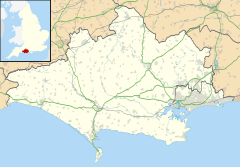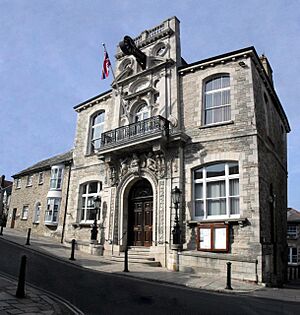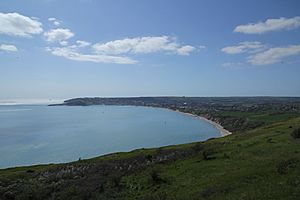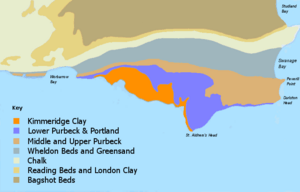Swanage facts for kids
Quick facts for kids Swanage |
|
|---|---|
| Town | |
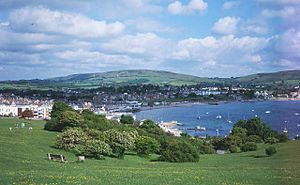 |
|
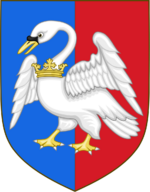 Coat of arms of Swanage |
|
| Population | 9,601 (2011) |
| OS grid reference | SZ0278 |
| Civil parish |
|
| Unitary authority |
|
| Ceremonial county | |
| Region | |
| Country | England |
| Sovereign state | United Kingdom |
| Post town | SWANAGE |
| Postcode district | BH19 |
| Dialling code | 01929 |
| Police | Dorset |
| Fire | Dorset |
| Ambulance | South Western |
| EU Parliament | South West England |
| UK Parliament |
|
Swanage (pronounced SWON-ij) is a lovely coastal town in the south-east of Dorset, England. It sits at the eastern end of the Isle of Purbeck. Swanage is about 6 miles (10 km) south of Poole and 25 miles (40 km) east of Dorchester. In 2011, about 9,601 people lived here.
Near Swanage, you can find Ballard Down and the famous Old Harry Rocks. To the north are Studland Bay and Poole Harbour. South of the town, you'll discover Durlston Bay and Durlston Country Park. The areas of Herston and Durlston are also part of Swanage.
This town started as a small port and fishing village. It grew a lot during the Victorian era. First, it became important for quarrying stone. Later, it turned into a popular seaside resort for wealthy people. Today, Swanage is still a busy tourist spot. Tourism is its main industry. Thousands of visitors come here in summer. They love the sandy beaches and other fun attractions.
Over time, Swanage has been called different names. These include Swanawic, Swanwich, and Sandwich. Its current name, Swanage, is more recent.
The town is at the eastern end of the Jurassic Coast. This coastline is so special it's a World Heritage Site. Swanage also has many historic buildings. Two areas, Swanage and Herston, are protected for their history.
Contents
Discovering Swanage's Past
Fishing was probably the first industry in Swanage. But quarrying, which means digging for stone, has been important since the first century AD. During the time of the Romans, this industry grew. A special stone called Purbeck marble was used. It decorated buildings as far away as London. After the Romans left, quarrying mostly stopped until the 12th century.
Early Mentions of Swanage
The town is first mentioned in old books in 877. This was in the Anglo-Saxon Chronicle. It talks about a big disaster for the Danish navy. The story says: "This year came the Danish army into Exeter from Wareham; whilst the navy sailed west about, until they met with a great mist at sea, and there perished one hundred and twenty ships at Swanwich."
A storm pushed the Danish ships onto Peveril Point. This is a rocky area at the south end of Swanage Bay. In 1862, John Mowlem built a monument there. It has cannonballs on top, though this is historically incorrect. The monument marks this event. People saw it as a great naval victory by King Alfred.
Stone Quarrying and Its Uses
In the 12th century, people wanted Purbeck Marble again. This marble is not good for outside buildings. It doesn't handle weather well. But it is strong and beautiful for inside columns. So, it was used in many big churches and cathedrals.
Besides marble, Purbeck limestone, or 'Purbeck stone', was also used. It has been a building material locally for a long time. Its use wasn't always written down. People just used it as the main building material.
New ways of quarrying started in the 17th century. This led to more stone being produced. The Great Fire of London in 1666 caused a lot of rebuilding. Purbeck stone was used a lot for paving. Around this time, stone began to be loaded onto ships directly from Swanage seafront. Before, it was taken to Poole for shipping.
Swanage Becomes a Tourist Spot
The idea of Swanage as a tourist place started in the early 1800s. A local Member of Parliament, William Morton Pitt, helped this idea. He turned a large house into a fancy hotel. In 1833, Princess Victoria visited this hotel. She later became queen. The building was then called the Royal Victoria Hotel. Today, it has been turned into flats, a bar, and a nightclub.
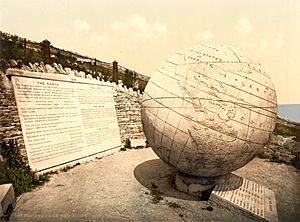
The Victorian Era: Mowlem and Burt's Influence
Swanage became most famous during the Victorian period. John Mowlem (1788–1868) was from Swanage. He became a very successful builder in London. His company, Mowlem, was a big construction firm.
John Mowlem brought stone from places like Purbeck to London. He and his nephew George Burt (1816–1894) brought many old items from London to Swanage. These items were used as weight for empty ships returning from London.
One example is the big clock tower near Peveril Point. This clock tower honors the Duke of Wellington. It was built in London in 1854. It stood at the entrance to the old London Bridge. But it got in the way of traffic. So, it was moved to Swanage in 1867–68. It now stands at the south end of the seafront.
Another item from London is the front of the 1860 Mercers' Hall. This was used for the front of the Swanage Town Hall. The Town Hall was built in the early 1880s. Behind the Town Hall is the Swanage lock-up, a small old jail from 1803.
Mowlem and Burt helped Swanage grow a lot. They built much of the town's important structures. This includes the first pier, the Mowlem Institute (a reading room), and the first gas and water works. They also developed the Durlston estate and Country Park. The Great Globe in Durlston Country Park was finished by George Burt in 1887. It is made of 15 stone sections. It weighs 40 tons (40,642 kg) and is 10 feet (3 meters) wide. Burt also put up the first public memorial to Prince Albert in 1862.
Swanage Lighthouse was built in 1880. It stands on the clifftop at Anvil Point, near Durlston Castle.
The railway came to Swanage in 1885. George Burt encouraged this. By then, the town was a popular place for wealthy visitors. It was known for its good weather and clean air. The railway made it much easier for people to visit. Direct trains ran from London. Even more visitors came when the second 'new' pier was built in 1895. This pier was mainly for pleasure boats.
From World Wars to Today
Swanage was a quiet, successful seaside resort for many years. The First World War did not leave many marks on the town. But during the Second World War, gun positions were built along the shoreline. The town also suffered bomb damage. Sadly, 20 people died. Swanage and nearby villages also helped develop radar.
After the Second World War, Swanage, like many resorts, faced hard times. Fewer people could afford holidays. In 1972, the Swanage railway line was closed. This was part of bigger railway cuts. But a group of local people formed a charity. They wanted to restore the line and run old steam and diesel trains. This created the Swanage Railway.
Swanage has also had problems with flooding. There was bad flooding in 1990. In 1993, a big project was finished to stop floods. This created a new 'jetty' for rainwater. But this caused a new problem. It stopped sand from moving north along the bay. Sand built up on the south side and disappeared from the north. This exposed the foundations of the seawall. So, the beach was improved in 2005–06. New wooden barriers called groynes were built. Also, 90,000 cubic meters of sand were added to the beach.

How Swanage is Governed
Swanage is run by the Swanage Town Council. This council is based at the Swanage Town Hall. It works with the new Dorset Council. Swanage has two councillors in Dorset Council. They represent the Swanage Ward.
In 2019, local government changed. Before, there were two levels of council. Now, there is one main council for rural Dorset. For national government, Swanage is part of the South Dorset area. Since 2024, Lloyd Hatton of the Labour Party represents this area.
Swanage Town Council's Role
The Swanage Town Council is the local authority. It provides many services. These include:
- Sports and recreation places
- The beach
- Tourist information
- Caravan parks
- Car parks
- Public toilets
- Cemeteries
- Allotments (small plots of land for growing food)
The Town Council has twelve elected councillors. They are chosen from two areas: Swanage North and Swanage South. Each councillor serves for four years. These councillors choose a chairman to be the Town Mayor. The council also has about 30 staff members. They are managed by the Town Clerk.
Geography and Natural Features
Swanage Bay faces east on the south coast of England. It is at the eastern end of the Isle of Purbeck. The northern part of the bay is made of chalk. The southern part is made of Purbeck Limestone. The middle of the bay and the valley are made of softer clays.
Purbeck limestone was dug out a lot. You can see old quarry sites to the south-west. These include Tilly Whim Caves and Dancing Ledge. Dancing Ledge is a man-made rock shelf used for loading ships. Natural wearing away of the land has created rock stacks. These are found along the northern headland. The most famous are the Old Harry Rocks.
During quarrying, fossils from the dinosaur age have been found. The coastline around Swanage Bay is part of the Jurassic Coast. This is a special World Heritage Site.
Swanage Climate
Like the rest of the British Isles, Swanage has a maritime climate. This means it has warm (but not hot) summers and cool winters. Because it's on the coast, Swanage has smaller temperature changes than places further inland.
The Met Office has a weather station in Swanage. The coldest temperature recorded was -9.4°C (15.1°F) in January 1963. The hottest was 30.2°C (86.4°F) in July 1976. Rain usually falls most in winter and least in summer. The town's position in an east-facing bay protects it from strong southwesterly winds.
| Climate data for Swanage (1991–2020) | |||||||||||||
|---|---|---|---|---|---|---|---|---|---|---|---|---|---|
| Month | Jan | Feb | Mar | Apr | May | Jun | Jul | Aug | Sep | Oct | Nov | Dec | Year |
| Mean daily maximum °C (°F) | 9.0 (48.2) |
8.9 (48.0) |
10.5 (50.9) |
12.8 (55.0) |
15.7 (60.3) |
18.3 (64.9) |
20.5 (68.9) |
20.6 (69.1) |
18.6 (65.5) |
15.5 (59.9) |
12.2 (54.0) |
9.8 (49.6) |
14.4 (57.9) |
| Mean daily minimum °C (°F) | 4.0 (39.2) |
3.7 (38.7) |
4.7 (40.5) |
6.3 (43.3) |
9.1 (48.4) |
11.7 (53.1) |
13.6 (56.5) |
13.8 (56.8) |
12.1 (53.8) |
9.7 (49.5) |
6.7 (44.1) |
4.5 (40.1) |
8.4 (47.1) |
| Average rainfall mm (inches) | 95.2 (3.75) |
67.3 (2.65) |
58.5 (2.30) |
52.1 (2.05) |
45.7 (1.80) |
50.9 (2.00) |
49.5 (1.95) |
54.9 (2.16) |
63.3 (2.49) |
98.4 (3.87) |
108.2 (4.26) |
108.1 (4.26) |
852.6 (33.57) |
| Average rainy days (≥ 1 mm) | 13.2 | 10.9 | 9.8 | 9.2 | 8.0 | 7.6 | 7.8 | 8.3 | 8.7 | 12.6 | 14.0 | 13.9 | 124.0 |
| Mean monthly sunshine hours | 66.5 | 88.4 | 134.7 | 188.1 | 222.0 | 226.9 | 236.0 | 213.1 | 167.3 | 119.8 | 81.2 | 61.0 | 1,805.5 |
| Source: Met Office | |||||||||||||
Swanage's Economy
Many people in Swanage work in shops, health care, or hotels and restaurants. Tourism is a big industry, but it's very busy only in summer. So, some people might need to travel to nearby towns like Poole or Bournemouth for year-round jobs.
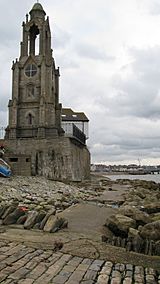
The town center has some larger shops and many local ones. There are also cafes, bars, restaurants, and pubs. Along the seafront, you'll find arcades, ice cream shops, and fish restaurants. Swanage also has many successful small businesses.
On the edge of town, there's a brickworks. It uses local clay to make bricks. Quarrying for stone still happens in the south of the area.
Tourism in Swanage
In summer, many people visit Swanage. They come for the beautiful scenery, the beach, and other attractions. The town has many hotels and guest houses. Swanage has a gentle, sandy beach that is usually calm. Local businesses offer refreshments and services there. You can rent deck chairs, boats, pedalos, and water sports gear. There are also arcades and parks.
Besides the beach, other fun places to visit include:
- The restored Swanage Steam Railway
- The Victorian Swanage Pier
- Durlston Country Park National Nature Reserve
You can also use Swanage as a base to visit other nearby places. A popular one is Corfe Castle.
Culture and Events
Swanage is a small town, so it doesn't have huge cultural places. But it has many small clubs and groups. The Swanage Town Band, for example, started in the late 1800s. The biggest place for entertainment is the Mowlem Theatre. It opened in 1967. It's a theatre with 400 seats and a cinema. It also has a bar, restaurant, and some shops. It usually shows about 200 films and has 60–100 live theatre nights each year.
Swanage has a local group of the Air Training Corps. They do activities around town. These include charity collections, training, and parades.
Festivals and Fun Events
The town hosts many yearly festivals and events. In summer, there's a carnival week. It includes a parade with floats and dancers. There are also fireworks displays and other attractions. You can enjoy live music, races, and a regatta (boat race).
The railway used to have special Thomas the Tank Engine events. They also have other special train services.
Swanage also has popular festivals that attract people from far away. These include:
- A jazz festival
- A folk festival
- A blues festival
- Plans for a future food festival
New Year's Eve is a big event in Swanage. Many people come from nearby areas. Some even travel long distances to celebrate. It's a tradition for people in Swanage to dress up for New Year's Eve. There's no special theme, just fun costumes!
Local Media
Local news and TV shows come from BBC South and ITV Meridian. TV signals are received from the Rowridge TV transmitter.
Local radio stations include:
- BBC Radio Solent on 96.1 FM
- Heart South on 102.3 FM
- Greatest Hits Radio South on 105.8 FM
- Nation Radio South Coast on 106.6 FM
- Purbeck Coast FM, a local community radio station on 101.2 FM
The town also has several local newspapers:
- The Swanage & Wareham Advertiser
- The Purbeck Gazette
- Swanage News
- Dorset Echo
Churches in Swanage
Swanage has several churches. Many of them are in historic buildings. St Mary's Anglican Church was rebuilt starting in 1860. Swanage Methodist Church was built in 1886. There are also three more Anglican churches. Other churches include Emmanuel Baptist Church, a Quakers' meeting house, Roman Catholic, Salvation Army, and United Reformed Church. All these churches work together in a group called "Churches Together in Swanage and District." This group also includes churches in Langton Matravers, Kingston, and Worth Matravers.
The town also has "The Old Stable." This is a Christian community center in the town center.
Getting Around Swanage
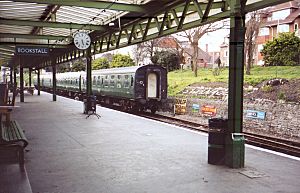
You can reach Swanage by road in a few ways. You can go through Wareham and its bypass. Or you can take the Sandbanks Ferry, which is a shorter way to Bournemouth. There's also a smaller road connecting Swanage to East Lulworth through Corfe Castle. But this road goes through a military firing range and is closed during firing practice.
Most bus services are run by Morebus. The Number 40 bus goes between Swanage and Poole. The Number 30 bus goes between Swanage and Weymouth (only in summer). The Number 50 bus goes between Swanage and Bournemouth, using the Sandbanks Ferry. In summer, double-deck open-top buses are used on the Poole and Bournemouth routes. These buses are called Purbeck Breezers. The Bournemouth to Swanage route was voted one of Britain's top three scenic bus routes in 2018.
Swanage has a restored heritage steam railway. It runs for most of the year. In 2013, the Swanage Railway received money to start regular services to the main line at Wareham. The railway connection is now open. It is mainly used in the summer months. In 2023, a regular service from Wareham started running four days a week between April and September.
There are also limited ferry services between Poole Quay and Swanage Pier. Swanage residents use these for shopping trips to Poole. Tourists in Poole use them for day trips to Swanage.
To avoid traffic through Corfe Castle village and parking in Swanage, there's a park and ride at Norden. You can take Swanage Railway steam trains or buses (routes 30 and 40) from there to Swanage. This, along with trains from Wareham, boat trips from Poole, and the scenic bus route from Bournemouth, gives many ways to visit Swanage. These options also help reduce your carbon footprint.
The closest main railway station to Swanage is Wareham. From there, South Western Railway trains go west to Dorchester South and Weymouth. Eastbound trains go to Poole, Bournemouth, Southampton Central, and London Waterloo.
National Express Coaches also run a daily coach service from Swanage to London. There's one trip each way: to London in the morning and back in the evening.
Education in Swanage
Current Schools
Swanage has four primary schools for children aged 5-11 (academic years 1–6):
- St Mary's Catholic Primary School
- St Mark's CE Primary School
- St George's CE Primary School
- Swanage Primary School (also known as Mount Scar)
Swanage has one secondary school, The Swanage School.
The town also has a library in the town center. It's in a unique building made of glass and Purbeck Stone from the 1960s.
A small museum, the Swanage Museum & Heritage Centre, is located on the seafront. It has items and displays about the town's history. The museum used to be in the old Tithe Barn building. But due to high maintenance costs, most of the collection moved to the new site.
Past Schools and Changes
Until 2013, schools in Purbeck District had a three-tier system. This meant children went to primary, then middle, then secondary school. Swanage Middle School was one of these. But in 2010, a change to a two-tier system was approved. This meant middle schools closed in September 2013. Primary schools in Swanage now teach children for two extra years (years 1–6). Children then move to secondary school from year 7 onwards.
Parents and teachers were concerned about these changes. So, they formed the Education Swanage group. They proposed creating a free school in the town for secondary education. Their idea was accepted in 2011. "The Swanage School" opened in September 2013. It was first in a temporary location. Pupils moved to the new building in Easter 2014.
Harrow House was a large language school in Swanage. It taught foreign students. The school had a big white dome that was a sports hall. It could be seen from far away. The school closed in 2020 and did not reopen.
Next to Harrow House was Purbeck View School. This school helped children and teenagers with autism. It also offered boarding. After some issues and fewer students, the school closed in August 2023.
There was also a Swanage Grammar School from 1929 to 1974.
Public Services
Swanage has a small fire station. It is run by Dorset & Wiltshire Fire and Rescue Service. Swanage Police Station opened in 1899 but closed in November 2012.
Swanage Hospital is a community hospital. It is run by Dorset Healthcare. There is also an Ambulance Station. The hospital has a Minor Injuries Unit for basic emergency care from 8 am to 8 pm. It also has other departments like inpatient, outpatient, and physiotherapy. Swanage Medical Practice provides GP services.
Because Swanage is on the coast, it has important sea safety services. These include:
- Swanage Lifeboat Station, run by the RNLI
- A HM Coastguard post
- A National Coastwatch Institution station
Sports and Recreation
Swanage has teams and clubs for many sports. These include football, rugby, cricket, croquet, hockey, sailing, and rowing.
Swanage Town and Herston F.C. is the local football team. They play in the Dorset Premier League. They have their own football ground. Swanage & Wareham Rugby Club is based in nearby Wareham. Swanage and Wareham Hockey Club has teams for ladies, men, and mixed players. Swanage Cricket Club has teams in both the Dorset Saturday and Sunday leagues. The town's Croquet Club is also at the Cricket Club.
The sea cliffs and old quarries near Swanage are great for rock climbing.
The areas around Swanage are excellent for walking. Many hikers use the town as a starting point. Beautiful places are within walking distance. The town is on the Dorset Coast Path. You can enjoy cliff walks to Old Harry Rocks and Studland to the north. To the south and west, you can walk to Durlston Head and Lulworth Cove.
Parks and Green Spaces
Swanage has a King George's Field near the town center. It honors King George V. This park has large playing fields, a skate park, and a modern play area. These were funded by community groups. There are plans to build a new sports building at the park.
Other parks in the town center include Prince Albert Gardens. This is where the Prince Albert Memorial is now located. The Recreation Ground has the war memorial and a bandstand.
Towards the east of town is Days Park. It has a playing field, a play area, and gardens.
Water Sports Fun
Swanage Bay is a safe place for many water sports. You can enjoy swimming, kayaking, canoeing, sailing, windsurfing, and jetskiing.
Scuba diving happens under the piers and at nearby shipwrecks. Many people consider Swanage to be the home of British scuba diving. It's a very popular place for dive schools and clubs to train new divers. This is because the bay is so sheltered. The dive school on the pier was the first in Great Britain.
Swanage Sailing club started in 1935. It is located just south of the pier.
Swanage Sea Rowing Club started in 2001. It has been very successful. It now has over 100 members and four Cornish pilot gigs (special rowing boats). They attend several competitions each year. This includes the World Pilot Gig Championships in the Isles of Scilly.
There are two public swimming pools. One is at Swanage Bay View Holiday Home Park. The other is at Ulwell Caravan Park. Both offer swimming lessons and aquarobic sessions.
Twin Town
Swanage is twinned with:
- Rüdesheim am Rhein in Germany.
Famous People and Swanage
From 1934 to 1936, artist Paul Nash lived in Swanage. He worked on a guide to Dorset and created many paintings and photos there. The surrealist artist Eileen Agar also stayed in Swanage at this time. Nash wrote an essay called "Swanage or Seaside Surrealism." He said the town felt like "a dream image where things are so often incongruous."
Artist and writer Philip Sugden was born and grew up in Swanage. He is known for his drawings and paintings of India and Tibet.
The Canadian poet, novelist, and painter P. K. Page was born in Swanage in 1916. She moved to Canada in 1919. She won a major Canadian award for poetry in 1954.
Swanage is said to be the hometown of John Cleese's character Basil Fawlty in the TV show Fawlty Towers.
The first episode of the second series of the British TV show The Inbetweeners, called "The Field Trip", is set mostly in Swanage. However, it was actually filmed in Littlehampton.
In 1997, a 12-mile (19 km) wide crater on Mars was named after Swanage.
Musician William Dorey, known as 'Skinshape', is from Swanage.
Swanage in Books
Swanage is called Knollsea in Thomas Hardy's novels. In The Hand of Ethelberta, it's described as "a seaside village lying snug within two headlands as between a finger and thumb."
In E. M. Forster's Howards End, Margaret and Mr. Wilcox have their first kiss there. The town is mentioned often throughout the book.
See also
 In Spanish: Swanage para niños
In Spanish: Swanage para niños


